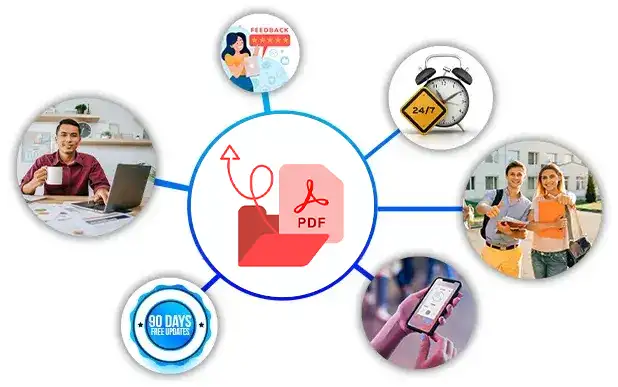ISC2 CSSLP PDF Exam Questions:
How to Get Success in ISC2 CSSLP Exam:
- Avoid deceptive CSSLP PDF Exam Questions.
- Focus on CSSLP Questions (PDF) based on the latest exam syllabus.
- Make notes of ISC2 CSSLP PDF for better learning.
- Prepare from our latest ISC2 CSSLP PDF file and get success in first attempt.


Prepare ISC2 CSSLP Exam Within Short Time
Your knowledge and abilities are validated by passing the ISC2 CSSLP exam. Our PDF questions and answers will help you prepare for the CSSLP exam in a short time because it includes questions similar to the real ISC2 exam questions. After downloading the CSSLP ISC2 PDF exam questions, relevant to the actual exam, you can take a print of all questions and prepare them anytime, anywhere.
Realistic Scenario Based ISC2 CSSLP PDF Exam Questions:
Everyone wants to become certified Certified Secure Software Lifecycle Professional and improve his/her resume. You should practice with real CSSLP questions. Students can benefit from the CSSLP exam questions which are available in PDF format. The CSSLP exam questions and answers are designed to match the criteria of the actual exam. If you use scenario-based ISC2 CSSLP questions you will have an extra potential to clear the exam on the first attempt.
You work as a Network Auditor for Net Perfect Inc. The company has a Windows-based network. While auditing the company's network, you are facing problems in searching the faults and other entities that belong to it. Which of the following risks may occur due to the existence of these problems?
See the explanation below.
Detection risks are the risks that an auditor will not be able to find what they are looking to detect. Hence, it becomes tedious to report
negative results when material conditions (faults) actually exist. Detection risk includes two types of risk:
Sampling risk: This risk occurs when an auditor falsely accepts or erroneously rejects an audit sample.
Nonsampling risk: This risk occurs when an auditor fails to detect a condition because of not applying the appropriate procedure or
using procedures inconsistent with the audit objectives (detection faults).
Answer A is incorrect. Residual risk is the risk or danger of an action or an event, a method or a (technical) process that, although being
abreast with science, still conceives these dangers, even if all theoretically possible safety measures would be applied (scientifically
conceivable measures).
The formula to calculate residual risk is (inherent risk) x (control risk) where inherent risk is (threats vulnerability). In the economic context,
residual means 'the quantity left over at the end of a process; a remainder'.
Answer D is incorrect. Inherent risk, in auditing, is the risk that the account or section being audited is materially misstated without
considering internal controls due to error or fraud. The assessment of inherent risk depends on the professional judgment of the auditor, and
it is done after assessing the business environment of the entity being audited.
Answer B is incorrect. A secondary risk is a risk that arises as a straight consequence of implementing a risk response. The secondary
risk is an outcome of dealing with the original risk. Secondary risks are not as rigorous or important as primary risks, but can turn out to be so
if not estimated and planned properly.
The National Information Assurance Certification and Accreditation Process (NIACAP) is the minimum standard process for the certification and accreditation of computer and telecommunications systems that handle U.S. national security information. Which of the following participants are required in a NIACAP security assessment?
Each correct answer represents a part of the solution. Choose all that apply.
See the explanation below.
The NIACAP roles are nearly the same as the DITSCAP roles. Four minimum participants (roles) are required to perform a NIACAP security
assessment:
IS program manager: The IS program manager is the primary authorization advocate. He is responsible for the Information Systems
(IS) throughout the life cycle of the system development.
Designated Approving Authority (DAA): The Designated Approving Authority (DAA), in the United States Department of Defense, is the
official with the authority to formally assume responsibility for operating a system at an acceptable level of risk.
Certification agent: The certification agent is also referred to as the certifier. He provides the technical expertise to conduct the
certification throughout the system life cycle.
User representative: The user representative focuses on system availability, access, integrity, functionality, performance, and
confidentiality in a Certification and Accreditation (C&A) process.
Answer D is incorrect. Information Assurance Manager (IAM) is one of the key participants in the DIACAP process.
Which of the following penetration testing techniques automatically tests every phone line in an exchange and tries to locate modems that are attached to the network?
See the explanation below.
The demon dialing technique automatically tests every phone line in an exchange and tries to locate modems that are attached to the
network. Information about these modems can then be used to attempt external unauthorized access.
Answer B is incorrect. In sniffing, a protocol analyzer is used to capture data packets that are later decoded to collect information such
as passwords or infrastructure configurations.
Answer D is incorrect. Dumpster diving technique is used for searching paper disposal areas for unshredded or otherwise improperly
disposed-of reports.
Answer C is incorrect. Social engineering is the most commonly used technique of all, getting information (like passwords) just by
asking for them.
Which of the following roles is also known as the accreditor?
See the explanation below.
Designated Approving Authority (DAA) is also known as the accreditor.
Answer A is incorrect. The data owner (information owner) is usually a member of management, in charge of a specific business unit,
and is ultimately responsible for the protection and use of a specific subset of information.
Answer B is incorrect. A Chief Risk Officer (CRO) is also known as Chief Risk Management Officer (CRMO). The Chief Risk Officer or Chief
Risk Management Officer of a corporation is the executive accountable for enabling the efficient and effective governance of significant risks,
and related opportunities, to a business and its various segments. Risks are commonly categorized as strategic, reputational, operational,
financial, or compliance-related. CRO's are accountable to the Executive Committee and The Board for enabling the business to balance risk
and reward. In more complex organizations, they are generally responsible for coordinating the organization's Enterprise Risk Management
(ERM) approach.
Answer C is incorrect. The Chief Information Officer (CIO), or Information Technology (IT) director, is a job title commonly given to the
most senior executive in an enterprise responsible for the information technology and computer systems that support enterprise goals. The
CIO plays the role of a leader and reports to the chief executive officer, chief operations officer, or chief financial officer. In military
organizations, they report to the commanding officer.
DoD 8500.2 establishes IA controls for information systems according to the Mission Assurance Categories (MAC) and confidentiality levels. Which of the following MAC levels requires high integrity and medium availability?
See the explanation below.
The various MAC levels are as follows:
MAC I: It states that the systems have high availability and high integrity.
MAC II: It states that the systems have high integrity and medium availability.
MAC III: It states that the systems have basic integrity and availability.
Reliable Source Of Preparation For Certified Secure Software Lifecycle Professional Exam.
We provide Certified Secure Software Lifecycle Professional certification questions along with answers to assist students in passing the ISC2 Exam. You can enhance your ISC2 CSSLP preparation with the help of an online practice engine. Try out our ISC2 CSSLP questions because 98% of Examskit users passed the final CSSLP exam in one go.
